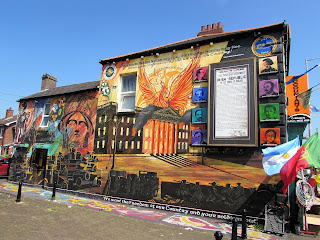 |
| A vibrant art scene in central Belfast |
After deindustrialization, and
“The Troubles,” the buildings and businesses of central Belfast bear witness to
the recent difficult times. Yet there are signs of revitalization and vitality.
The area around the St. Ann’s Cathedral is bustling with inviting restaurants
and traditional pubs. Live music emanates from several venues, and I have
decided it is a requirement that every street performer must have a version of
“Brown Eyed Girl” in their repertoire. As with every city that is recovering,
there is an edginess to Belfast. Although the Good Friday Peace Accords were
more than two decades ago, signaling an end to the violence between the Catholic
and Protestant communities in Belfast and Northern Ireland, some areas of the
city exude a mistrust concerning their neighbors.
It is odd to reflect upon how
many maps of cities I have in my head. Sometimes I might forget how to get from
point A to point B before I return to a city. But when I arrive, I usually
figure it out. The pathway and connection between landmarks and streets comes
back to me almost instantly. Perhaps most odd is my still emerging knowledge of
Belfast. To have an intimate knowledge and understanding of Falls Road and
Shankill Road in West Belfast is disorienting. I was in high school during some
of the most egregious violence of the Troubles, and while I did not understand
the circumstances or implications then, my view of Belfast was that it was a
city of violence and danger. In my mind, I saw Belfast and Northern Ireland as
a war-torn region, akin to places like Beirut during its civil war.
 |
| The gate on Northumberland that each night closes |
I have a sense of unease when I
walk the streets of Belfast. While visiting other places, like Babelplatz and
Potsdammerplatz in Berlin, I understand the horrific atrocities and loss of
life that occurred there. But what happened in Belfast was in my near-adult
lifetime. The news photographs and footage, I can recall vividly. I remember
sitting at the kitchen table, eating breakfast before school, hearing about the
death of Bobby Sands during the hunger strike. I would soon be off to college,
pursuing a degree in political science, and news was a dissonance about how
Western Europe was supposed to operate. Those memories still persist today as I
wander the streets of Belfast.
 |
| Mural on the Falls Road (Republican) |
 |
| Mural on the Shankill Road (Loyalist) |
Despite the peace between the
communities, West Belfast in many respects remains divided, both literally and
figuratively. Murals in the Republican and Loyalist sections, along the Falls
Road and the Shankill Road, tell two different stories. It is almost as if
there is a belief that the peace is a respite; the old animosities still exist
and once again the argument will be had again. The gates on Lanark Way and
Northumberland Street still close every night to separate the communities.
Houses next to the wall that divides the communities still employ fences to
prevent bricks from coming through their windows. Even neighborhood libraries,
those bastions of knowledge, understanding and contemplation feel different.
There is less than half a mile between Falls Road and Shankill Road branches,
but the displays, book suggestions and art reflect the two different
communities. One wonders how the communities move on from a lack of violence to
real integration of neighborhoods.
No comments:
Post a Comment